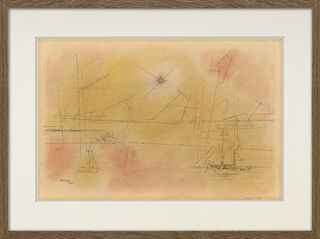
Lyonel Feininger
1871-1956
Lyonel Feininger is known for his depictions of streets, cities and ships, which are composed of prismatically broken forms and inspired by Cubism and the art of Robert Delaunay.
The painter and graphic artist was born in New York in 1871 as the son of German musicians. He first came to Germany at the age of 16 for a concert tour of his parents and stayed there to study at the Hamburg School of Applied Arts and later at the Royal Prussian Academy in Berlin. After a study visit to Paris, he continued living and working for many years in Germany, where he was close to the "Blauer Reiter" artists' group. Starting in 1919, he made his mark as a master for the graphic workshops of "Bauhaus" in Weimar, Dessau and Berlin.
Feininger, along with Schlemmer, most explicitly realised the Bauhaus ideal of order. For him, the starting point is not the human figure but architecture, the strict geometric structure of forms that he observed in Gothic churches. His studies of the architecture of small German towns established his light-flooded, prismatic style, which was to become a model for many artists.
Feininger first devoted himself to German townscapes and churches. During the National Socialist era, the Nazi Party officially declared Feininger’s work to be "degenerate", which forced him to return to New York in 1937. There he created his famous impressions of the architecture of Manhattan and New York.




